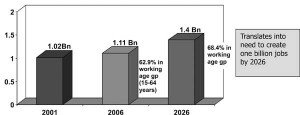Capital Intensive Growth
India has witnessed a fantastic phase of economic growth since the liberalisation of its economy in 1991. However, what needs to be noted is that this growth has largely been capital intensive so far. India has been liberated from the mediocrity and inefficiencies of the public sector and the license – quota Raj. The private sector is now booming and has become globally competitive. Unfortunately, this has not translated into an increase in jobs/large scale employment generation. The growth has been capital intensive.17 To illustrate, let us take the example of the Tatas, one of India’s leading industrial houses.
- In 1991, its steel plant at Jamshedpur was producing one million tonnes of steel and it employed a huge workforce of some 85,000 people.
- In 2005, this plant was producing five million tonnes of steel but its work force had shrunk to just 44,000 people.
- Tata Steel’s turnover has risen from US $ 800 million in 1991 to over US $ 4 billion in 2005. Its top executives estimate that they could hike up production to 10 millions tonnes and yet cut down the workforce to just 20,000.18
- Tata has therefore transformed itself from a labour intensive company which supplied low cost steel to the domestic market, to a capital intensive company supplying world class automobile steel to ‘top of the line’ car manufacturers in Japan and elsewhere. Yet, instead of generating greater employment, it has drastically scaled down the company’s work force as the development has been capital intensive.19
China’s growth in contrast, has been labour intensive and thereby serves to employ many more people. Less than 7 per cent of India’s dauntingly large work force is employed in the formal economy (called the organised sector). This means that only 35 million people out of 470 million people have job security in any meaningful sense.20 The rest are in the unorganised sector and make up India’s seasonal army of mobile, casual farm workers, running small shops or street-side stalls, making incense sticks and bidis, driving rickshaws, working as watchmen, gardeners, maids or mechanics in small town garages. The organised work sector in China, in contrast, employs a 100 million people.21 Of the 35 million people in India’s organised sector, 21 million are direct employees of the government. Only 14 million are in the private sector and out of these only 0.25 per cent, or one million are employed in the lucrative IT sector.22
Demographic Dividend or Demographic Bomb
When we analyse the emerging socio-economic fractures or fault lines in the Indian polity, we are struck by the enormity of the challenges that are now crystallising, and could have a serious bearing on our internal security and stability in the decades ahead. India’s population in 2006 was stated to be 1.1 billion, 62.9 per cent of this was in the working age group. While the population growth curve itself is likely to flatten, India is experiencing what demographers have called a youth bulge. This means that the proportion of the population in the 15-64 years working age group will increase steadily for another 35 years till 2045. India’s working age population alone could then rival that of China. The graph below illustrates this clearly.
 This clearly highlights that by 2026, India’s population will be 1.4 billion. Of this some 68.4 per cent (or nearly 70 per cent) are likely to be in the working age group of 15-64. This translates into a billion strong workforce and hence the need to create a billion jobs! Such youth bulges have traditionally been associated with bloody revolutions in human history. A more optimistic way to look at this problem would be to contrast India’s youth bulge with the ageing populations in USA, Europe, Russia and China. Optimists assume that we could export cheap labour or outsource jobs on a massive scale and hence feel that the youth bulge will give India a demographic dividend. The Indian economy is booming at 9 per cent per annum. However, it is required to grow at a sustained rate that generates growth that is not just capital intensive but manpower intensive and can generate employment for a billion strong workforce.
This clearly highlights that by 2026, India’s population will be 1.4 billion. Of this some 68.4 per cent (or nearly 70 per cent) are likely to be in the working age group of 15-64. This translates into a billion strong workforce and hence the need to create a billion jobs! Such youth bulges have traditionally been associated with bloody revolutions in human history. A more optimistic way to look at this problem would be to contrast India’s youth bulge with the ageing populations in USA, Europe, Russia and China. Optimists assume that we could export cheap labour or outsource jobs on a massive scale and hence feel that the youth bulge will give India a demographic dividend. The Indian economy is booming at 9 per cent per annum. However, it is required to grow at a sustained rate that generates growth that is not just capital intensive but manpower intensive and can generate employment for a billion strong workforce.




